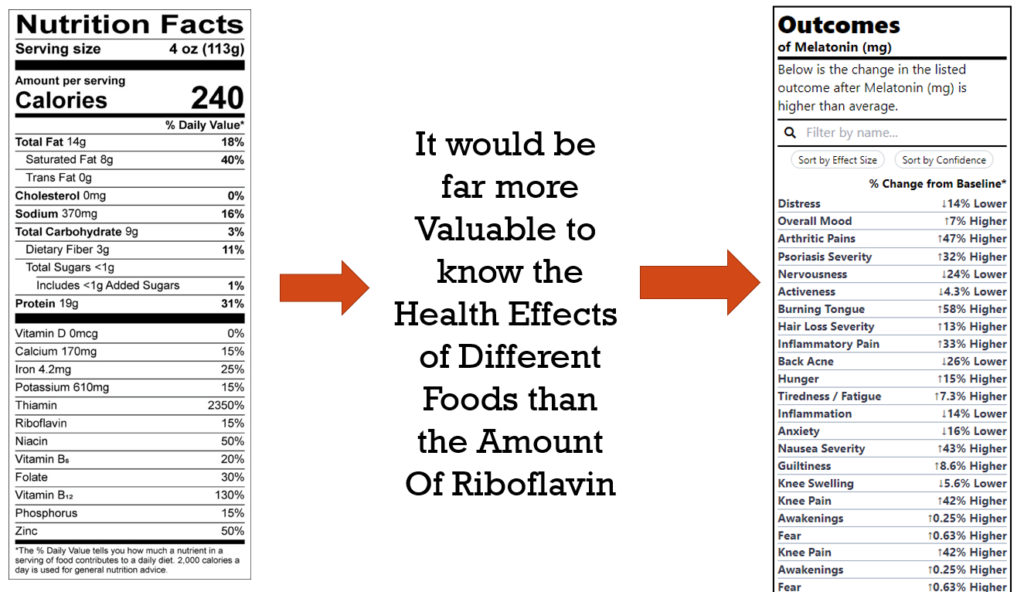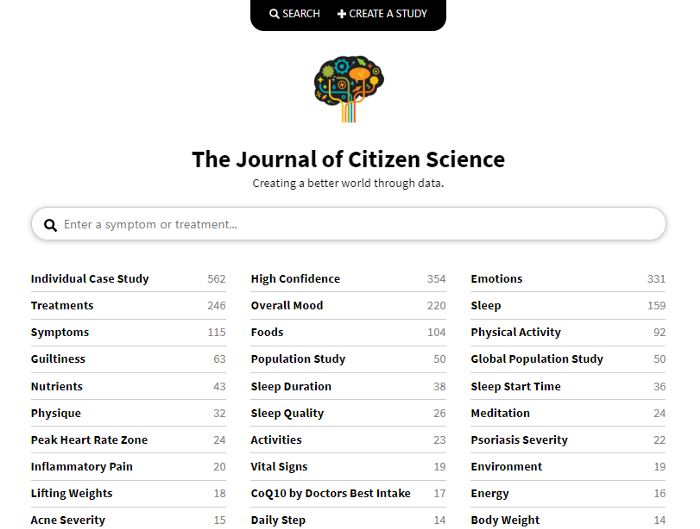We publish our anonymously aggregated analyses at the Journal of Citizen Science. So far, we’ve collected over 10 million data points on symptom severity and influencing factors from over 10,000 people. This data has been used to freely publish 90,000 studies on the effects of various treatments and food ingredients on symptom severity.
Mega Studies
Mega studies can be focused on either:
- an outcome of interest such as the severity of a disease or
- a predictor such as a food or a drug
Outcome Mega Studies
Outcome Mega Studies summarize all available analyses to determine the factors most likely to improve or exacerbate a symptom of chronic illness.
Predictor Mega Studies
Predictor Mega Studies summarize all available analyses to determine the most likely positive or negative effects of a given factor such as a food or a drug.
Data Sources
- Individual Micro-Level Data – This could include data manually entered or imported from other devices or apps at app.crowdsourcingcures.org, This could also include shopping receipts for foods, drugs, or nutritional supplements purchased and insurance claim data.
- Macro-Level Epidemiological Data – This includes the incidence of various diseases over time combined with data on the amounts of different drugs or food additives. This is how it was initially discovered that smoking caused lung cancer. With macro-level data, it’s even harder to distinguish correlation from causation. However, different countries often enact different policies that can serve as very useful natural experiments. For instance, 30 countries have banned the use of glyphosate. If the rates of Alzheimer’s, autism, and depression declined in these countries and did not decline in the countries still using glyphosate, this would provide very powerful evidence regarding its effects. Unfortunately, there is no global database that currently provides easy access to the incidence of these conditions in various countries over time and the levels of exposure to various chemicals.
- Clinical Trial Data – This is the gold standard with regard to the level of confidence that a factor is truly the cause of an outcome. However, it’s also the most expensive to collect. As a result, clinical trials are often very small (less than 50 people). Exclusion criteria in trials often prevent study participants from being representative of real patients. There are ethical considerations that prevent us from running trials that have any risk of harm to participants. Due to the expense involved we have very few trials run on anything other than a molecule that can be patented and sold as a drug.
Causal Network Graphs
Network graphs indicate the likely predictive strength of the effect of various factors on an outcome. Clicking the link between two nodes will take one to a more detailed analysis of the relationship.

Causal Flow Charts
Sankey charts indicate the likely predictive strength of the effect of various factors on an outcome in terms of the width of the link. Clicking the link between two nodes will take one to a more detailed analysis of the relationship.

Intuition-Based Likely Cause Survey Results
Individuals may provide their own intuitive reports as to the most likely factors exacerbating their symptoms.

Predictor Search
The Predictor Search allows one to search for the likely effects of a specific factor on the current outcome.

Outcome Labels
Currently, all foods carry nutrition labels such as this one:

But how useful is it to the average person to know the amount of Riboflavin in something? The purpose of nutritional labels is to help individuals make choices that will improve their health and prevent disease.
Telling the average person the amount of riboflavin in something isn’t going to achieve this. This is evidenced by the fact that these labels have existed for decades and during this time, we’ve only seen increases in most diseases they were intended to reduce.
We have created a new and improved Outcomes Label that instead lists the degree to which the product is likely to improve or worsen specific health outcomes or symptoms. We currently have generated Outcome Labels for thousands of foods, drugs, and nutritional supplements that can be found at studies.crowdsourcingcures.org. These labels are derived from the analysis of 10 million data points anonymously donated by over 10,000 study participants via the app at app.crowdsourcingcures.org.

